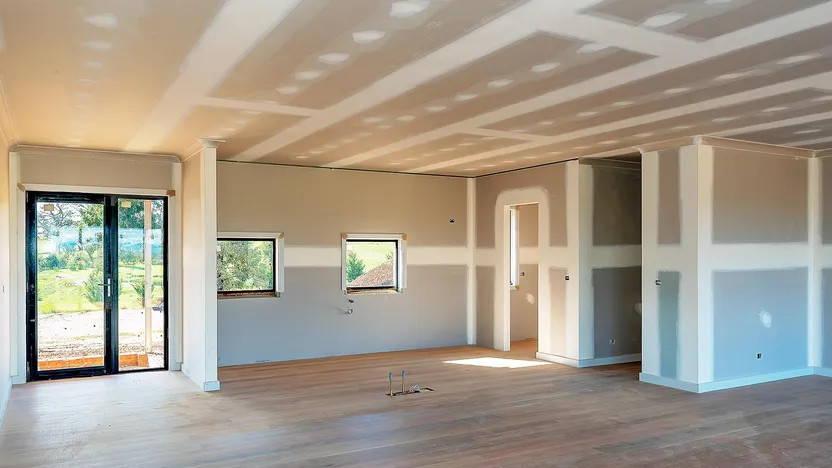Sep 12, 2023

The current inventory crunch means finding a house within your budget is tougher than ever.
But what’s that you say? You found a house that’s half-built and on the market at a bargain price? There are myriad reasons why the homeowner may have abandoned the project and listed it for sale. For instance, the homeowner could have run out of money, divorced, or passed away.
If you stumble upon that listing, it might be tempting to think about completing the project yourself and turning it into your dream home. (You can almost hear Chip and Joanna cheering you on!)
But before fantasies of the grand reveal take over the reality of finishing a home, hit the pause button. There are some essential things you should consider before making an offer.
Be realistic about expectations
So, the house you have your eye on is in a great location with good bones. But just how unfinished is it?
If there’s no drywall, no toilet in the bathroom, and the kitchen lacks cabinets or appliances—think twice. The potential is there, but think about what it takes to make the home livable.
“Potential buyers need to determine the scope of the work, whether they plan to do it themselves or hire contractors, and whether such an undertaking is financially feasible given their individual circumstances,” advises Jennifer Sjoblom, broker associate with Baird & Warner in Frankfort, IL.
Pull the permits
A partly finished home means your potential abode might be riddled with permit headaches that don’t meet local building codes or a lack of permits altogether.
So it’s critical to call the local building department to ask if permits were pulled for construction and if the home passed an inspection. Some municipalities might require a Freedom of Information Act request to get the info.
The process can be time-consuming, so if you want to make an offer on a home quickly, be sure to include a contingency clause.
“You can add a provision to the contract or during attorney review stating that the deal is contingent upon the buyer receiving, reviewing, and approving the information from the FOIA request,” Sjoblom explains.
And be sure to get a home inspection for any permitted work that was completed. If the project was halted because of permits and failed inspections that were too costly to address, it might prove too expensive for you to tackle, even with a low sales price.
Estimate the costs and time to finish
That kitchen is a blank canvas screaming for architectural pendants and mixed-material cabinets with statement hardware. Yet, the not-so-fun stuff like the HVAC and electrical and plumbing should be the primary focus.
“I recommend setting a structural budget first and then seeing what’s left for the design elements,” advises Sjoblom.
Aside from money, it’s essential to be realistic about the time needed to finish a large-scale project. Materials are in short supply these days, and workers are in high demand. You might have to wait longer than you think to cross the threshold and settle in.
Living in an unfinished house
Maybe you’re determined enough to live with a subfloor, no handrails on the stairs, and unfinished plumbing projects. But are you allowed to live in an unfinished house while working on it?
“Some municipalities require an occupancy permit and will not issue one until all necessary repairs are completed and the home has passed an inspection,” says Sjoblom.
Financing might be tricky
Contrary to popular opinion, you can’t get a conventional mortgage to buy an unfinished house.
However, there are home loans that cater to unfinished property scenarios. These short-term specialty loans typically have a higher interest rate but can be converted to long-term, traditional amortized mortgages. Here are the most common types.
- Renovation loans pertain to modifying an existing structure. “They cover both the purchase price and the renovation costs, making them ideal for buyers who wish to personalize or invest in homes needing upgrades,” says David A. Krebs, a mortgage broker at DAK Mortgage in Miami.
- Construction loans are for houses still under construction. “‘Under construction’ denotes that the primary structure of the house is yet to be completed,” says Krebs. This loan finances the building or completion process, with disbursements usually tied to construction milestones.
- FHA 203(k) from the Federal Housing Administration offers two types of mortgage rehab loans. The Limited 203(k) is ideal for homes with minor repairs and renovations. The Standard 203(k) is designed for properties requiring more work, including structural changes. “If the unfinished house you’re considering demands significant work, this is probably the option to consider,” says Krebs. The program has loan limits, making it a tad tricky in higher-priced areas, particularly in primary and occasionally secondary markets.
- Bridge loans are suitable for buyers interested in an unfinished property while awaiting the sale of their current home. “These loans bridge the financial gap between buying a new property and selling an existing one,” says Krebs.
Source- https://www.realtor.com/advice/buy/interested-in-buying-an-unfinished-home-the-truth-about-taking-on-what-someone-else-started/






